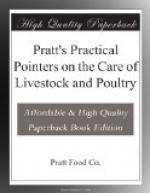-------------------------------------------------------
---------- Madison, Wis.
I think every
man that owns horses should have Pratts Animal
Regulator on hand.
I am a teamster and find it of great benefit to
my horses, whether
run down or not.
HARRY E. BURMEISTER_ ------------------------------------------------------------
-----
[Illustration: CLYDESDALE HORSE]
A spavined horse starts out lame for a few steps or rods and then goes sound. A lame shoulder causes dragging of the toe and rolling when in motion. A ring-bone causes an extra long step and lameness increases with exercise. Stifle lameness causes walking on the heels of shoe and consequent wearing of the iron. Hip lameness causes outward rolling of the leg in trotting, and wasting of the muscles of stifle and hip leads to a characteristic drop. See that the horse’s tail is sound, has not been joined on and is free from sores, tumors or evidences of recent docking. Always remember to back the horse up as well as drive or ride him and see that he is not only sound and gentle but suitable for the special work he will be required to do.
[Illustration: Care of the Horse]
Care of the Horse
A grown work horse requires daily about one pound of grain (concentrate) for each hundred pounds of live weight. Of hay he will need a slightly larger amount or about fourteen to eighteen pounds a day, according to size, weight, and character of work done. The idle horse will do well on less grain and more roughage.
For a farm horse, 10 pounds of oats, 5 pounds of corn, and 3 pounds of bran, divided into three equal feeds, will make a suitable ration for one day.
The corn may be fed at noon to give variety. For the evening meal crushed oats, bran, and a few handfuls of cut hay, wetted and salted, will be relished. The bulk of the hay should be fed at night, and but two or three pounds of it at noon, during hot weather. Avoid dusty hay. Clover hay is apt to be moldy. It is suitable food for work horses, or idle drafters, if sound and not too liberally fed. Increase the corn in cold weather. Omit it in hot weather entirely. Alfalfa is of high feeding value, but if moldy, or fed as a well-nigh exclusive ration, is apt to affect the kidneys injuriously. It is deemed unsafe food for stallions, as it is said to induce impotence or sterility.
Horses should drink before they eat, unless they have ready access to fresh water. It is best to allow drinking water often in small quantities, even if the horse is hot. So used it will not hurt him. The horse’s stomach holds three and one-half gallons. Water flows through the stomach along seventy or more feet of small intestine, into the “waterbag.” Hay is not digested to any extent in the stomach. That organ cares for the concentrated food. Theoretically, a horse should drink first, then eat hay, then grain. Practically no great amount of water should be taken just after a meal as it tends to flush undigested food out of the stomach; nor should it be given soon after a meal.




